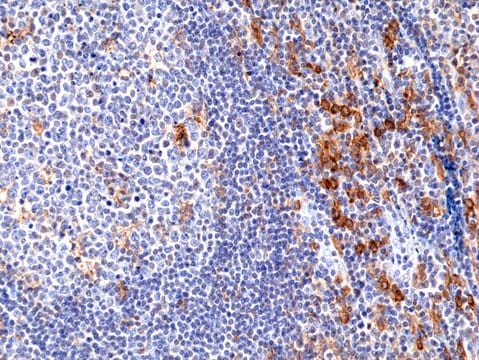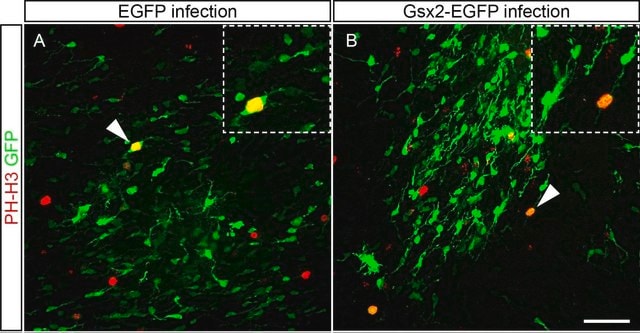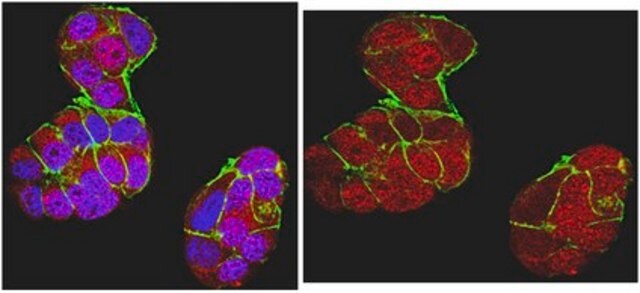推薦產品
生物源
rabbit
品質等級
共軛
unconjugated
抗體表格
affinity isolated antibody
抗體產品種類
primary antibodies
無性繁殖
polyclonal
形狀
buffered aqueous glycerol solution
物種活性
human
技術
immunohistochemistry: 1:200-1:500
免疫原序列
CTAQNLLGSISTIGRLQVEGARVVAEPGLDVPEGAALNLSCRLLGGPGPVGNSTFAWFWNDRRLHAEPVPTLAFTHVARAQAGMYH
UniProt登錄號
運輸包裝
wet ice
儲存溫度
−20°C
目標翻譯後修改
unmodified
基因資訊
human ... SIGLEC1(6614)
一般說明
Sialic acid-binding Ig-like lectin 1 (SIGLEC1), also known as CD169, is a myeloid-cell surface receptor that belongs to the Siglec family. It is expressed on the surface of specific macrophage subsets and its precursor monocytes. In addition, it also shows its expression on some dendritic cells or T lymphocytes. SIGLEC1 is encoded by the gene mapped to human chromosome 20p. The protein structure is characterized with 17 Ig-like domains, including an N-terminal V-set domain and 16 C2-set domains.
免疫原
sialic acid binding Ig-like lectin 1, sialoadhesin recombinant protein epitope signature tag (PrEST)
應用
Anti-SIGLEC1 antibody produced in rabbit has been used in immunohistochemistry.[1]
生化/生理作用
Sialic acid-binding Ig like lectin 1 (SIGLEC1) aids in cell-to-cell adhesion and cell-pathogen interactions. It also enables antigen presentation and induces adaptive immune responses. SIGLEC1 facilitates attenuation and induces anti-tumor immunity. It suppresses anti-viral innate immune response by inducing ubiquitin ligase tripartite motif-containing 27 (TRIM27) mediated TANK binding kinase 1 (TBK1) degradation. SIGLEC1 is used as a predictive molecular marker in several autoimmune diseases, such as Grave′s diseases. Upregulationof the SIGLEC1 has been observed in patients with systemic sclerosis (SSc).
特點和優勢
Prestige Antibodies® are highly characterized and extensively validated antibodies with the added benefit of all available characterization data for each target being accessible via the Human Protein Atlas portal linked just below the product name at the top of this page. The uniqueness and low cross-reactivity of the Prestige Antibodies® to other proteins are due to a thorough selection of antigen regions, affinity purification, and stringent selection. Prestige antigen controls are available for every corresponding Prestige Antibody and can be found in the linkage section.
Every Prestige Antibody is tested in the following ways:
Every Prestige Antibody is tested in the following ways:
- IHC tissue array of 44 normal human tissues and 20 of the most common cancer type tissues.
- Protein array of 364 human recombinant protein fragments.
聯結
Corresponding Antigen APREST85314
外觀
Solution in phosphate buffered saline, pH 7.2, containing 40% glycerol and 0.02% sodium azide.
法律資訊
Prestige Antibodies is a registered trademark of Merck KGaA, Darmstadt, Germany
免責聲明
Unless otherwise stated in our catalog or other company documentation accompanying the product(s), our products are intended for research use only and are not to be used for any other purpose, which includes but is not limited to, unauthorized commercial uses, in vitro diagnostic uses, ex vivo or in vivo therapeutic uses or any type of consumption or application to humans or animals.
未找到適合的產品?
試用我們的產品選擇工具.
儲存類別代碼
10 - Combustible liquids
水污染物質分類(WGK)
WGK 1
閃點(°F)
Not applicable
閃點(°C)
Not applicable
Javier Martinez-Picado et al.
Nature communications, 7, 12412-12412 (2016-08-12)
Siglec-1/CD169 is a myeloid-cell surface receptor critical for HIV-1 capture and infection of bystander target cells. To dissect the role of SIGLEC1 in natura, we scan a large population genetic database and identify a loss-of-function variant (Glu88Ter) that is found
Michael R York et al.
Arthritis and rheumatism, 56(3), 1010-1020 (2007-03-01)
Microarray analyses of peripheral blood leukocytes have shown that patients with systemic lupus erythematosus express increased levels of type I interferon (IFN)-regulated genes. In this study we examined gene expression by peripheral blood mononuclear cells (PBMCs) from patients with systemic
Robert M Clancy et al.
Journal of immunology (Baltimore, Md. : 1950), 202(1), 48-55 (2018-12-07)
Given that diseases associated with anti-SSA/Ro autoantibodies, such as systemic lupus erythematosus and Sjögren syndrome, are linked with an upregulation of IFN and type I IFN-stimulated genes, including sialic acid-binding Ig-like lectin 1 (Siglec-1), a receptor on monocytes/macrophages, recent attention
Yu Liu et al.
Biomedical reports, 14(2), 26-26 (2021-01-08)
CD169+ macrophages are a unique type of macrophage subset that differ from M1 and M2 macrophages. CD169+ macrophages are present in multiple tissues and organs throughout the body and are primarily expressed in secondary lymphoid organs. These cells are primarily
R Biassoni et al.
Journal of cellular and molecular medicine, 7(4), 376-387 (2004-02-03)
NK cells express receptors characterized by opposite functions that finely regulate their activities. Among inhibitory receptors, some are specific for different groups of MHC class I alleles, while others are still orphan receptors. On the contrary, various activating receptors are
Active Filters
我們的科學家團隊在所有研究領域都有豐富的經驗,包括生命科學、材料科學、化學合成、色譜、分析等.
聯絡技術服務








